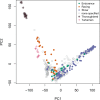Genome Diversity and the Origin of the Arabian Horse
- PMID: 32546689
- PMCID: PMC7298027
- DOI: 10.1038/s41598-020-66232-1
Genome Diversity and the Origin of the Arabian Horse
Abstract
The Arabian horse, one of the world's oldest breeds of any domesticated animal, is characterized by natural beauty, graceful movement, athletic endurance, and, as a result of its development in the arid Middle East, the ability to thrive in a hot, dry environment. Here we studied 378 Arabian horses from 12 countries using equine single nucleotide polymorphism (SNP) arrays and whole-genome re-sequencing to examine hypotheses about genomic diversity, population structure, and the relationship of the Arabian to other horse breeds. We identified a high degree of genetic variation and complex ancestry in Arabian horses from the Middle East region. Also, contrary to popular belief, we could detect no significant genomic contribution of the Arabian breed to the Thoroughbred racehorse, including Y chromosome ancestry. However, we found strong evidence for recent interbreeding of Thoroughbreds with Arabians used for flat-racing competitions. Genetic signatures suggestive of selective sweeps across the Arabian breed contain candidate genes for combating oxidative damage during exercise, and within the "Straight Egyptian" subgroup, for facial morphology. Overall, our data support an origin of the Arabian horse in the Middle East, no evidence for reduced global genetic diversity across the breed, and unique genetic adaptations for both physiology and conformation.
Conflict of interest statement
The authors declare no competing interests.
Figures







References
-
- Olsen, S. & Culbertson, C. A gift from the desert: the art, history, and culture of the Arabian horse. (Kentucky Horse Park, 2010).
-
- Forbis, J. The classic Arabian horse. 1st edn, (Liveright, 1976).
-
- Olsen, S. L. & Bryant, R. T. Stories in the Rocks: Exploring Saudi Arabian Rock Art. (Carneigie Museum of Natural History, 2013).
-
- Khadka, R. Global Horse Population with respect to Breeds and Risk Status Master’s Degree thesis, Swedish University of Agricultural Sciences (2010).
Publication types
MeSH terms
LinkOut - more resources
Full Text Sources

